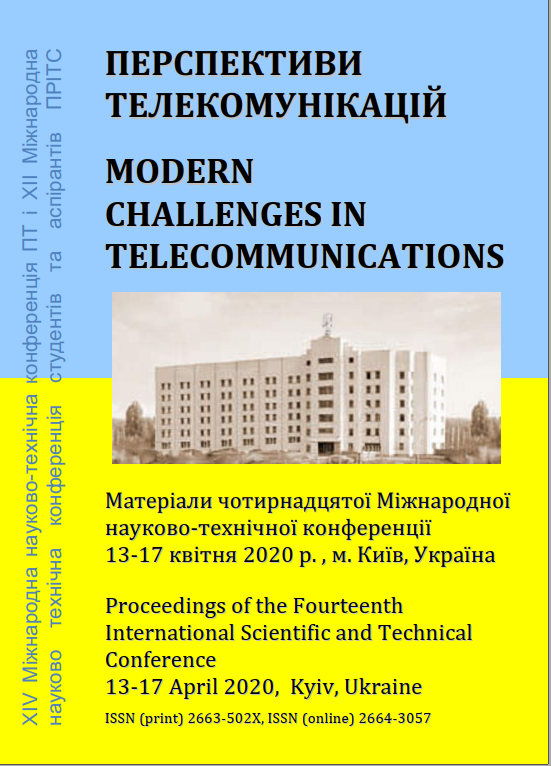КОНЦЕПЦИЯ ГРАНИЧНИХ ОБИЧИСЛИНЬ В МЕРЕЖІ МОБІЛЬНОГО ОПЕРАТОРА
Ключові слова:
MEC, PoW, 5GАнотація
На сьогоднішній день існують дві концепції граничних обчислень на підприємстві: установка фізичного обладнання та хмарні рішення. Блокчейн, як основна технологія нині популярної цифрової валюти Bitcoin, стала перспективною децентралізованою базою управління даними. Незважаючи на те, що блокчейн широко застосовується у багатьох програмах, його застосування в мобільних послугах все ще обмежене. Оскільки, витрачаються значні ресурси з точки зору часу та енергії процесора. Щоб полегшити програмам блокчейн у майбутніх мобільних системах крайові обчислення виступають рішенням. В роботі запропоновано концепцію крайових обчислень для мобільних блокчейнів.
CONCEPT OF EDGE COMPUTING
IN MOBILE OPERATOR NETWORK
Mankivskyi Volodymyr, Pedko Andryi
Institute of Telecommunication Systems, Igor Sikorsky Kyiv Polytechnic Institute, Ukraine
Today, there are two concepts of mobile edge computing (MEC): the installation of physical equipment and cloud solutions. Blockchain, as the main technology of the now popular digital currency Bitcoin, has become a promising decentralized data management base. Although blockchain is widely used in many applications, its use in mobile services is still limited. Because, it consumes considerable resources in terms of CPU time and energy. To make blockchain programs easier on future mobile systems, edge computing is the solution. The paper proposes the concept of boundary computing for mobile blockchains.
Посилання
R. Pass and E. Shi, “FruitChains: A Fair Blockchain,” PODC‘17 Proc. ACM Symp. Principles of Distributed Computing, Washington, DC, July 25–27, 2017, pp. 315–24.
S. Wang, et al., “A Survey on Mobile Edge Networks: Convergence of Computing, Caching and Communications,” IEEE Access, vol. 5, 2017, pp. 6757–79.
Romanov O, Mankivskyi V. Optimal traffic distribution based on the sectoral model of loading network elements, IEEE Problems of Infocommunications. Science and Technology Trans. Multimedia, 2019, pp. 210–219.
Y. Guo, L. Duan, and R. Zhang, “Optimal Pricing and Load Sharing for Energy Saving with Cooperative Communications,” IEEE Trans. Wireless Commun., vol. 15, Sept.2016, pp. 951–64.
Z. Xiong, et al., "When Mobile Blockchain Meets Edge Computing", IEEE Access, vol. 5, August,2018, pp. 33 - 39.
O.I. Romanov, M.M. Nesterenko, L.A. Veres. IMS: Model and calculation method of telecommunication network's capacity // Proceedings of the 2017 International Conference on Information and Telecommunication Technologies and Radio Electronics (UkrMiCo) 11-15 Sept. 2017 Year, Odessa, Ukraine. - ІEEE Conference Publications.
K. Christidis and M. Devetsikiotis, “Blockchains and Smart Contracts for the Internet of Things,” IEEE Access, vol. 4, May 2016, pp. 2292–2303.
Mariia Skulysh, Romanov Oleksandr. The structure of a mobile provider network with network functions virtualization. // Advanced Trends in Radioelecrtronics, Telecommunications and Computer Engineering, 2018 14th International Conference on. IEEE, 2018 - pp.: 1032 – 1034.
##submission.downloads##
Як цитувати
Номер
Розділ
Ліцензія
Авторське право (c) 2020 Володимир Броніславович Маньківський, Андрій Дмитрович Педько

Ця робота ліцензується відповідно до Creative Commons Attribution 4.0 International License.
Authors who submit to this conference agree to the following terms:a) Authors retain copyright over their work, while allowing the conference to place this unpublished work under a Creative Commons Attribution License, which allows others to freely access, use, and share the work, with an acknowledgement of the work's authorship and its initial presentation at this conference.
b) Authors are able to waive the terms of the CC license and enter into separate, additional contractual arrangements for the non-exclusive distribution and subsequent publication of this work (e.g., publish a revised version in a journal, post it to an institutional repository or publish it in a book), with an acknowledgement of its initial presentation at this conference.
c) In addition, authors are encouraged to post and share their work online (e.g., in institutional repositories or on their website) at any point before and after the conference.

